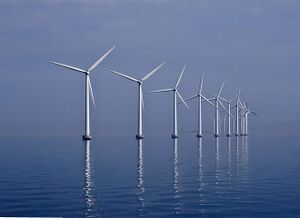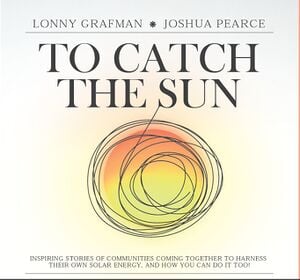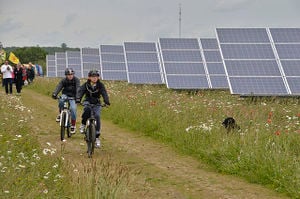
Community energy is considered here in the context of the wider topic of Sustainable energy.
Sustainable energy is defined, for the purposes of this article, as energy which, in its production or consumption, has minimal negative impacts on human health and the healthy functioning of vital ecological systems, including the global environment, and that can be supplied continuously to future generations on earth. Such forms of energy include, but are not limited to the following: solar thermal, solar photo-voltaic (PV), wind, hybrid wind-solar, fuel cell, geothermal, small-scale (mini- and pico-) hydro-electric, tidal and wave. This definition specifically excludes nuclear and fossil fuel energy or their "improvements" as an option thereof.[1]
My passion isn't for hydro, it's for people taking control of their own futures.
 Veterans of Alaska’s Oil Industry Look to Blaze a Renewable Energy Pathway in the State, insideclimatenews.org (Oct 07, 2024)
Veterans of Alaska’s Oil Industry Look to Blaze a Renewable Energy Pathway in the State, insideclimatenews.org (Oct 07, 2024)  ‘You basically have free hot water’: how Cyprus became a world leader in solar heating, theguardian.com (Sep 20, 2024)
‘You basically have free hot water’: how Cyprus became a world leader in solar heating, theguardian.com (Sep 20, 2024)  In Somalia, global warming makes a war-torn country even worse. But there’s also passion—and enterprise—for regenerative energy solutions, Daily Alternative (Sep 19, 2024)
In Somalia, global warming makes a war-torn country even worse. But there’s also passion—and enterprise—for regenerative energy solutions, Daily Alternative (Sep 19, 2024)
Networks[edit | edit source]
Creative Commons
LeNSes (Learing Network on Sustainable energy systems), multi-polar Network for curricula and lifelong learning capacity development focused on System Design for Sustainable Energy for All. It is a 3 year project (Oct 2013 - Oct 2016) funded by the European Commission (ACP-EU Edulink II), involving 3 design schools in Europe and 4 in Africa.
Other
- 100% Renewable Energy Cities & Regions Network, iclei.org
- micro hydropower on Yahoo Groups
- Sustainable energy on pinterest
How to's[edit | edit source]


To Catch the Sun by Lonny Grafman and Joshua Pearce is part of a series on people coming together to use their own resources and creativity to meet their needs with instructions on how you can do it too.
Sign up to get a free copy of the ebook at http://tocatchthesun.com/ or purchase a softback at a local bookstore or on Amazon.
Brought to you by backers on Kickstarter. 440 backers brought in over $20,000 to help make this book a beautiful addition to your library.
ISBN 978-1-947112-62-9 Library of Congress Control Number: 2021947789
In Spanish: https://tocatchthesun.com/?lang=es
In French: https://tocatchthesun.com/?lang=fr
Maps[edit | edit source]
- The world by renewable energy use, mapped, Jun 30, 2017, indy100.com
- work with the sun®, Mapdwell
Other resources[edit | edit source]
- microgridknowledge.com, added 15:22, 10 February 2020 (UTC)
- Two Energy Futures
Citizens data initiative
In developing countries, more than 1 billion people have no access to reliable electricity and more than 2.5 billion people rely on polluting and inefficient biomass and coal use for cooking and heating.[2]
Community action projects[edit | edit source]
- Microgeneration
- Community energy projects
- Energy awareness weeks
- Promoting energy efficiency
- Energy audits
- Fuel poverty Projects
- Energy Credit Unions
- Community owned energy sources
- Sustainable hydropower
- Community solar gardens
Energy poverty[edit | edit source]
Energy poverty is lack of access to modern energy services. It refers to the situation of large numbers of people in developing countries whose well-being is negatively affected by very low consumption of energy, use of dirty or polluting fuels, and excessive time spent collecting fuel to meet basic needs. It is inversely related to access to modern energy services, although improving access is only one factor in efforts to reduce energy poverty. Energy poverty is distinct from fuel poverty, which focuses solely on the issue of affordability.
According to the Energy Poverty Action initiative of the World Economic Forum, "Access to energy is fundamental to improving quality of life and is a key imperative for economic development. In the developing world, energy poverty is still rife. Nearly 1.6 billion people still have no access to electricity, according to the International Energy Agency (IEA).". As a result of this situation, a new UN initiative has been launched to coincide with the designation of 2012 as the International Year for Sustainable Energy for All, which has a major focus on reducing energy poverty. W
Community solar farm[edit | edit source]

A community solar farm or garden is a solar power installation that accepts capital from and provides output credit and tax benefits to individual and other investors. In some systems you buy individual solar panels which are installed in the farm after your purchase. In others you purchase kW capacity or kWh of production. The farm's power output is credited to investors in proportion to their investment, with adjustments to reflect ongoing changes in capacity, technology, costs and electricity rates. Companies, cooperatives, governments or non-profits operate the farms.
Centralizing the location of solar systems has advantages over residential installation that include:
- Trees, roof size and/or configuration, adjacent buildings, the immediate microclimate and/or other factors which may reduce power output.
- Building codes, zoning restrictions, homeowner association rules and aesthetic concerns.
- Lack of skills and commitment to install and maintain solar systems.
- Expanding participation to include renters and others who are not residential property owners. W
See also: Community solar
Decentralized energy[edit | edit source]
Distributed energy, also district or decentralized energy is generated or stored by a variety of small, grid-connected devices referred to as distributed energy resources (DER) or distributed energy resource systems.
Conventional power stations, such as coal-fired, gas and nuclear powered plants, as well as hydroelectric dams and large-scale solar power stations, are centralized and often require electricity to be transmitted over long distances. By contrast, DER systems are decentralized, modular and more flexible technologies, that are located close to the load they serve, albeit having capacities of only 10 megawatts (MW) or less.
DER systems typically use renewable energy sources, including small hydro, biomass, biogas, solar power, wind power, and geothermal power, and increasingly play an important role for the electric power distribution system. A grid-connected device for electricity storage can also be classified as a DER system, and is often called a distributed energy storage system (DESS). By means of an interface, DER systems can be managed and coordinated within a smart grid. Distributed generation and storage enables collection of energy from many sources and may lower environmental impacts and improve security of supply. W
Energy audit[edit | edit source]
An energy audit is an inspection, survey and analysis of energy flows for energy conservation in a building, process or system to reduce the amount of energy input into the system without negatively affecting the output(s). An energy audit is the first step in identifying opportunities to reduce energy expense and carbon footprints. W
Energy efficiency[edit | edit source]
According to the International Energy Agency, improved energy efficiency in buildings, industrial processes and transportation could reduce the world's energy needs in 2050 by one third, and help control global emissions of greenhouse gases.
Energy efficiency and renewable energy are said to be the twin pillars of sustainable energy policy and are high priorities in the sustainable energy hierarchy. In many countries energy efficiency is also seen to have a national security benefit because it can be used to reduce the level of energy imports from foreign countries and may slow down the rate at which domestic energy resources are depleted. W
Microgeneration[edit | edit source]
Microgeneration is the small-scale generation of heat and electric power by individuals, small businesses and communities to meet their own needs, as alternatives or supplements to traditional centralized grid-connected power. Although this may be motivated by practical considerations, such as unreliable grid power or long distance from the electrical grid, the term is mainly used currently for environmentally conscious approaches that aspire to zero or low-carbon footprints or cost reduction. W
Microgrids[edit | edit source]
A microgrid is a localized grouping of electricity generation, energy storage, and loads that normally operates connected to a traditional centralized grid (macrogrid). This single point of common coupling with the macrogrid can be disconnected. The microgrid can then function autonomously. Generation and loads in a microgrid are usually interconnected at low voltage and it can operate in DC, AC, or the combination of both. From the point of view of the grid operator, a connected microgrid can be controlled as if it were one entity.
Microgrid generation resources can include stationary batteries, fuel cells, solar, wind, or other energy sources. The multiple dispersed generation sources and ability to isolate the microgrid from a larger network would provide highly reliable electric power. Produced heat from generation sources such as microturbines could be used for local process heating or space heating, allowing flexible trade off between the needs for heat and electric power.
Micro-grids were proposed in the wake of the July 2012 India blackout:
Micro-grids have seen implementation in a number of communities over the world. For example, Tesla has implemented a solar micro-grid in the Samoan island of Ta'u, powering the entire island with solar energy. This localized production system has helped save over 380 cubic metres (100,000 US gal) of diesel fuel. It is also able to sustain the island for three whole days if the sun were not to shine at all during that period. This is a great example of how micro-grid systems can be implemented in communities to encourage renewable resource usage and localized production.
- End Wikipedia Sourcing
Microgrids are also noted to be a more reliable source of energy production and distribution than the larger microgrid system. This is due to their increased resilience to blackouts caused by extreme weather events and power shutoffs. Since microgrids can operate as an island system in the case of an event where power is lost from the main transmission lines into the macro grid system, microgrids are still able to function. Furthermore, microgrids can provide power to key infrastructure points that require a consistent source of power in order to operate effectively. This makes them potentially incredibly valuable when looking into he future of our energy distribution grid.
Microgrids can also help communities take control of their own power by decreasing it's reliance on the macro grid. This could help make electricity prices more affordable in these communities. They re also much easier to construct and maintain making them key when attempting to fight any areas experiencing an energy crisis. There are also government incentives attached to microgrids in order to make they more affordable, attached to their typical status as a renewable energy source.[3]
Sustainable community energy system[edit | edit source]
A sustainable community energy system is an integrated approach to supplying a local community with its energy requirements from renewable energy or high-efficiency co-generation energy sources. The approach can be seen as a development of the distributed generation concept.
Such systems are based on a combination of district heating, district cooling, plus 'electricity generation islands' that are interlinked via a private wire electricity system (largely bypassing the normal power grid to cut transmission losses and charges, as well as increasing the robustness of the system). The surplus from one generating island can therefore be used to make up the deficit at another. W
Campaigns[edit | edit source]
- Reclaim Power, global collaboration connecting climate and energy struggles
Near you[edit | edit source]
Community energy UK - Community energy UK news - Community energy USA
local information and news can be found, or shared, via our many location pages
See also[edit | edit source]
External links
- Wikipedia:Sustainable energy, Microgeneration, Community solar farm, Energy generation and uses, Energy harvesting, Efficient energy use, Cogeneration, District heating, District cooling, Energy audit, Energy hierarchy, Stand-alone power system, Energy conservation (category), Renewable energy (category)
- We Care Solar
- WISIONS
- World Alliance for Decentralized Energy raises the profile of all forms of decentralized energy or distributed generation including renewable technologies such as solar PV and small scale wind power. W
References
- ↑ Nuclear power is sometimes presented as a sustainable, clean energy source. However, "(a)s long as the limited supply of rich uranium ores hold out, the nuclear energy fuel chain does indeed, after about 7 years of operation, produce less CO2 than a gas-burning plant. But when the uranium content of ores gets below around 0.05%, it becomes doubtful if nuclear power will lead to the production of any less CO2 than just burning fossil fuel directly." (IVEM Centre for Energy & Environmental Studies, University of Groningen, Netherlands, April 2001). Further, "at all stages of nuclear power generation, nuclear energy produces substantial amounts of waste and environmental pollution (from uranium mining tailings through to spent nuclear fuel, plutonium, and other highly radioactive wastes). [Although the nuclear reactor of a nuclear power station does not, in itself, produce any CO2,] the nuclear fuel chain is a significant source of carbon dioxide emissions; it causes radioactive contamination of the air, water and land…and encourages the proliferation of nuclear weapons…" (Pacific News Bulletin, January 2001.)
- ↑ wwf.org.uk
- ↑ https://www.pacificdataintegrators.com/insights/microgrid-pros-and-cons






